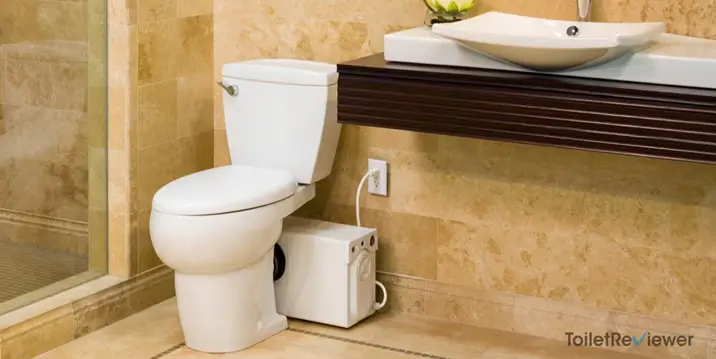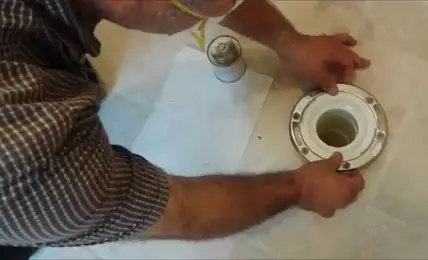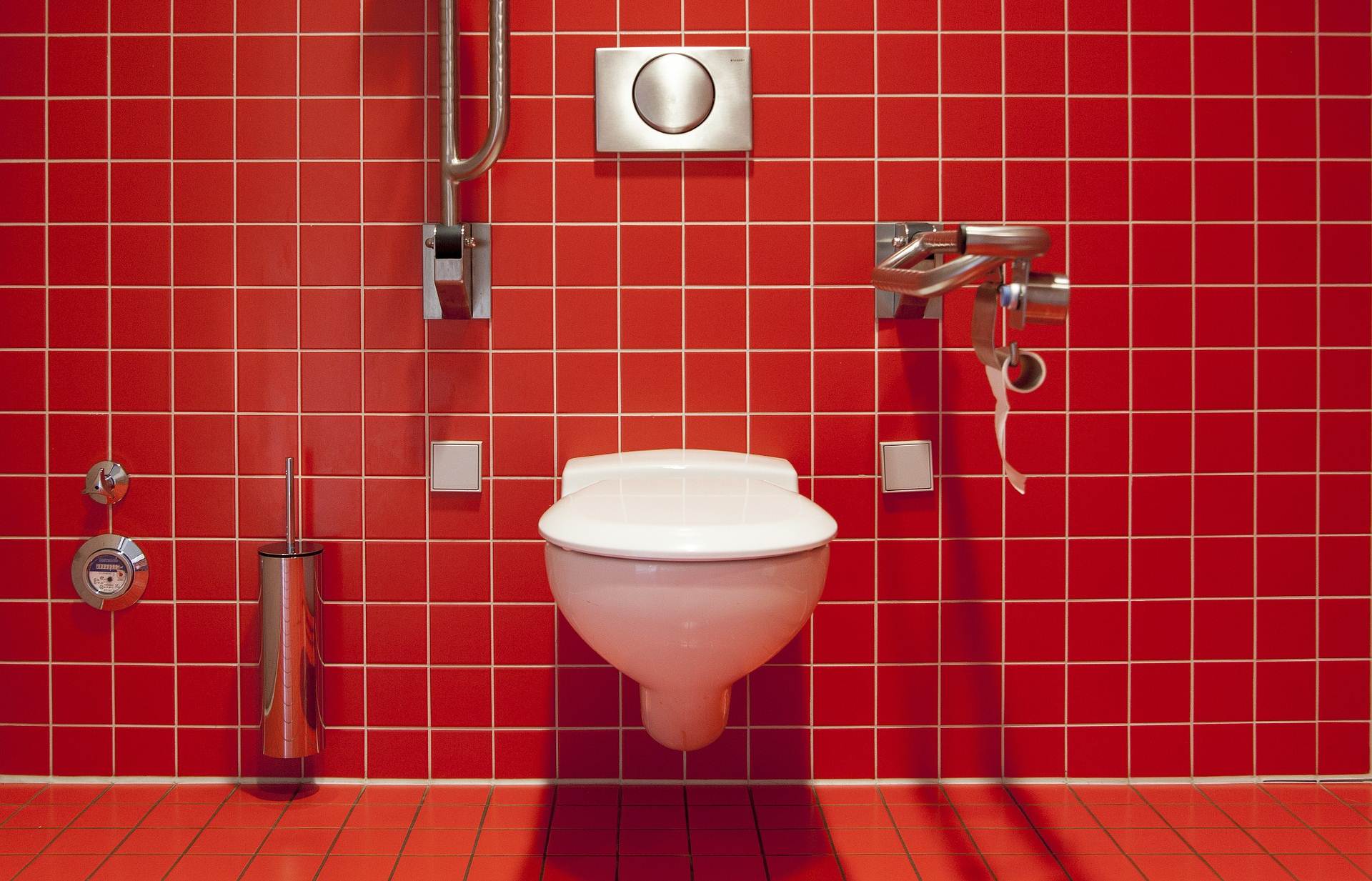A composting toilet is a type of dry toilet that serves as a temporary human waste management system. It decomposes the waste into usable manure. When used appropriately, these toilets have many benefits.
For example, they save on water and energy usage. Composting toilets are environmentally friendly and offer a safe and portable waste management solution.
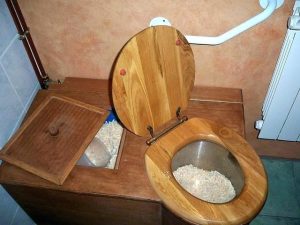 Composting Toilets are a special type of toilet that is designed to treat human waste using a biological process. While conventional toilets feed into mixed grey-water and black-water septic systems, a composting toilet is designed to process the waste on-site.
Composting Toilets are a special type of toilet that is designed to treat human waste using a biological process. While conventional toilets feed into mixed grey-water and black-water septic systems, a composting toilet is designed to process the waste on-site.
Most composting toilets require no water to flush or process human waste, but a few models use a small amount of water or foam to flush the waste. Either way, these toilets will help you save a significant amount of water in the bathroom every day.
There are two main types of composting toilets:
Self-contained Composting Toilets
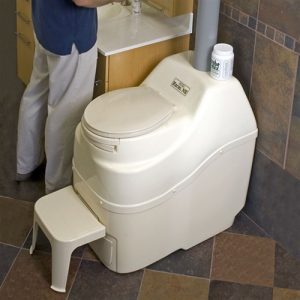 These toilets do not require a connection to the central system. Such units are comparatively easier to install and best suited for second-floor installations. Since they are not connected, these toilets are equipped with drawers or trays that can be emptied.
These toilets do not require a connection to the central system. Such units are comparatively easier to install and best suited for second-floor installations. Since they are not connected, these toilets are equipped with drawers or trays that can be emptied.
Central Composting Systems
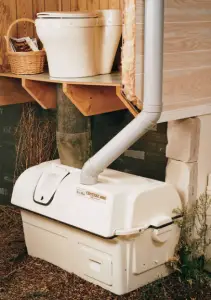 These toilets often feature a large tank with a slopped bottom to allow waste to slide down as it composes. Most of the central composting toilets are fitted with an access door on the lower end of this chamber. The more advanced models, especially the best commercial composting toilets, have multiple chambers
These toilets often feature a large tank with a slopped bottom to allow waste to slide down as it composes. Most of the central composting toilets are fitted with an access door on the lower end of this chamber. The more advanced models, especially the best commercial composting toilets, have multiple chambers
Each of these chambers contains human waste at different composting stages. With these models, you may be required to stir the contents of the chambers periodically.
How Does a Composting Toilet Work?
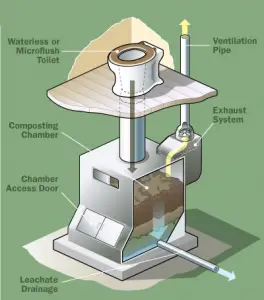 Composting toilets are meant to separate liquid waste from solid human waste, compost the solid human waste quickly and without odor, and produce compost that is safe to handle. Different manufacturers use different techniques to achieve these tasks.
Composting toilets are meant to separate liquid waste from solid human waste, compost the solid human waste quickly and without odor, and produce compost that is safe to handle. Different manufacturers use different techniques to achieve these tasks.
The waste entering the toilets is over 90 percent water, which needs to be evaporated through a ventilation system. The remaining solid material is converted to fertilizer through natural decomposition. The best decomposing toilets work in three main stages:
Evaporation
The first stage is aimed at separating liquid waste from solid waste and evaporating the liquid waste after that. To speed up the process, some models have a vent system that helps get rid of any water in the waste. Advanced toilets are even fitted with a heating element to speed up evaporation.
For extra efficiency, other self-composting toilets feature a urinal system. This ensures that most of the liquid is already separate from solid waste as it enters the composting chamber.
Composting
If left alone, the solid waste would eventually decompose, but the process would be awfully slow and smelly. To speed things up, these toilets create a conducive environment for bacterial decomposition in the composting chamber. This is often achieved by adding a bulking materials as peat mix or sawdust.
Bulking materials allow for proper aeration of the compost pile. This speeds up bacterial activity in the pile, and helps breakdown the compost quickly. Additionally, the bulking materials ensure that the final product is safe to handle.
How to Use a Composting Toilet
The operation and maintenance of a composting toilet is rather easy. It involves opening and closing the vaults as well as keeping the composting chamber interior and shelter clean. You also need to remove the compost when it is ready as well as inspect the unit for damage on a monthly basis.
A self-composting toilet has to be used correctly in order to prevent foul odors, and to stop flies from breeding in the toilet. Here are some tips to help you use your composting toilet correctly:
Preparing a Composting Toilet for Use
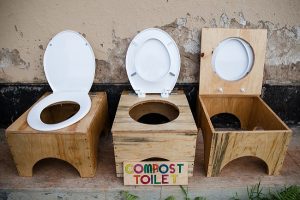 Composting toilets often have multiple vents, but only one may be used at a time. When not in use, the vents should be covered using a heavy lid.
Composting toilets often have multiple vents, but only one may be used at a time. When not in use, the vents should be covered using a heavy lid.
Before you use a vent, you need to prepare it properly. The most cost-effective way of doing this is to add a loose layer of weeds, leaves, sawdust or grass clippings.
You also need to have a jar or box of powdered soil or ashes as well as enough cleansing supplies like toilet paper in the toilet shelter at all times.
Using a Composting Toilet
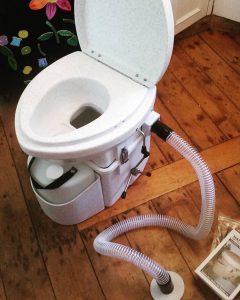 Open the heavy lid on the vent you would like to use and use the toilet as you would use a conventional one. Once you are done, wipe yourself and sprinkle fine earth or ashes into the vault using the jar or box of ashes in the toilet shelter.
Open the heavy lid on the vent you would like to use and use the toilet as you would use a conventional one. Once you are done, wipe yourself and sprinkle fine earth or ashes into the vault using the jar or box of ashes in the toilet shelter.
This is meant to prevent fly breeding in the waste and to curb odors. You may also throw yard sweepings and kitchen scraps into the vault at the end of each day.
Once or twice a week put in grass clippings, straw, leaves, or sawdust to form a layer above the contents of the vault. If you happen to overfill the toilet, do not worry as bacterial action will eventually reduce the volume.
Clean your composting toilet at least once each week by sprinkling ashes or powdered soil on the slab and around the squatting hole, and then sweeping them into the vault. Remember to replenish your supply of ashes or fine soil in the box.
Removing the Compost Heap
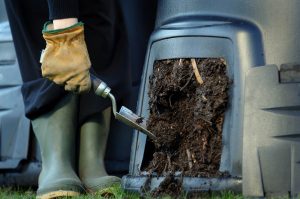 If sealed and maintained properly, the compost heap should be ready in 6 to 12 months, depending on the type of composting toilet you’ve got. When ready for removal, open the cover on the rear wall opening of the composting chamber.
If sealed and maintained properly, the compost heap should be ready in 6 to 12 months, depending on the type of composting toilet you’ve got. When ready for removal, open the cover on the rear wall opening of the composting chamber.
Using a rake or shovel, remove the compost and load it onto a cart or wheelbarrow. Leave the shallow layer of the heap in the vault, and close the cover on the composting chamber and prepare the vault for use.
What Happens To The Waste In A Composting Toilet?
A composting toilet uses the same process as garden composting to break down human manure. The waste is usually mixed with peat moss or sawdust. You end up with organic matter rich in nutrients.
What to Do with Composting Toilet Waste
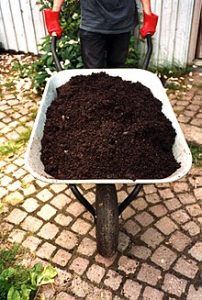 When handling this compost pile, it is advisable to wear disposable gloves and a dust mask. After collecting the compost pile from your toilet, you may add it to a compost pile to continue decomposing.
When handling this compost pile, it is advisable to wear disposable gloves and a dust mask. After collecting the compost pile from your toilet, you may add it to a compost pile to continue decomposing.
You may also use it as manure. For example, you can spread the compost on your lawn and water it.
Composting toilet waste may also be applied around fruit trees in your garden. You can also use the compost as manure in your non-edible garden.
Does a Composting Toilet Smell?
With the best composting toilet models, you wont need to worry about smell coming from the toilet, so long as you use it properly. In some cases, you may detect a slight earthy smell, but nothing as bad as you may expect.

